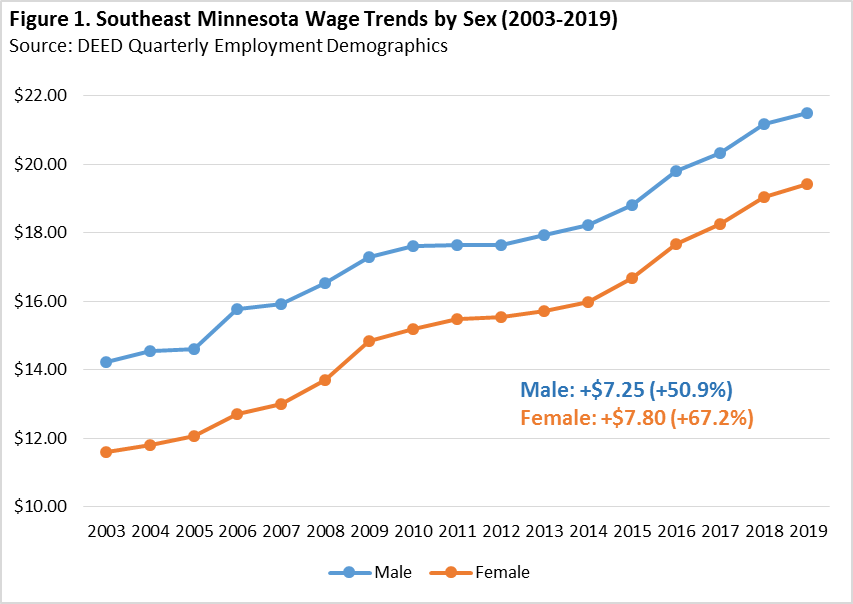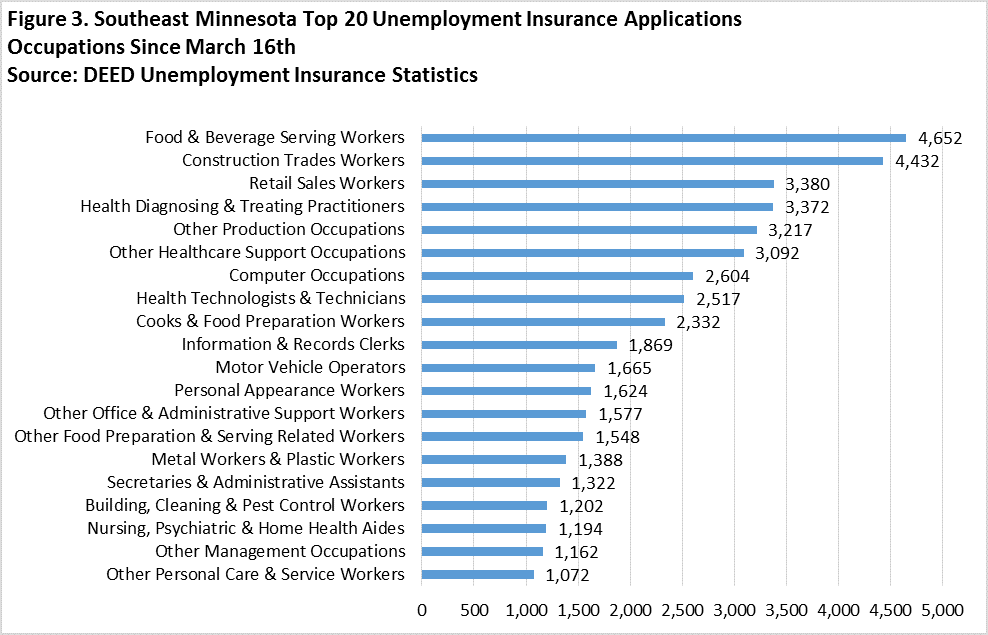By Mark Schultz
August 2020
Because of the industries and occupations they work in, women were more impacted by the shutdowns related to the coronavirus pandemic this spring. At the peak of the layoff activity in early May, females accounted for 59 percent of continuing claims for Unemployment Insurance (UI) in Southeast Minnesota. By August, even as the economy was re-opening, 55 percent of continuing claims in the region were still being filed by females.
According to numbers from the U.S. Census Bureau, the 257,081 women in the Southeast Minnesota region slightly outnumber the 254,228 men. Women, however, make up a slightly smaller number of participants in the labor force (131,533 females compared to 143,466 males). Data from the American Community Survey show that women in the region have a lower labor force participation rate (65.1 percent) than men (72.4 percent).
One contributing factor to the lower participation rate may be the presence of children in the household, with more women at remaining home to care for the child(ren) compared to men. For example, there are far more female-headed households with children under the age of 18 in the region (10,904) than male-headed households with children under the age of 18 (4,820).
Women also tend to have lower earnings than men in the region, at least partly from their choice of industry and occupation. Wage comparisons can be made using DEED's Quarterly Employment Demographics (QED) data, which show that many industries that have a higher concentration of male workers also pay higher wages than those with a higher percentage of female workers.
For example, QED data show that men make up a higher percentage of workers in the Utilities industry (80 percent), which has a median hourly wage of $36.17 across all jobs. In contrast, women are more likely to work (58 percent) in the Accommodation and Food Services industry, with a median wage of $11.90 across all jobs in the industry. Based on full-time hours, this difference leads to an annual earnings difference of over $50,000 – quite a substantial difference.
But beyond that, in this particular example not only are women in the Accommodation and Food Services industry earning less each hour, they are also working fewer hours – the median hours worked for females in the Accommodation and Food Services industry is 147 per quarter, compared to males in the Utilities industry working a median 520 hours per quarter, which would increase this wage differential even more. A detailed analysis of the industries shows more of these discrepancies, covered in an article in the February 2018 issue of Employment Review.
Progress was being made in the wage differential, as shown in Figure 1. Over time the increase in median hourly wages has been higher for women than men. Since 2003 the median hourly wage across all jobs in all industries has risen by 67.2 percent for women and 50.9 percent for men. (NOTE: the 2019 data is for the second quarter of 2019 whereas the other estimates are annual averages.)

The onset of COVID-19 in the Southeast region also hit women harder than men, especially in the early weeks. As shown in Figure 2, the number of women applying for unemployment insurance benefits was significantly higher during the first two weeks during which applications were being tracked – women's applications sat at 9,296 compared to 5,997 applications by men. Claims were also significantly higher during the weeks ending April 25 through May 9. It wasn't until the week ending on May 23 that the number of applications by male workers began consistently, albeit minimally, to outnumber those of female workers. This has lasted through the last week in which data were available, the week ending on July 25. By then, however, the damage had already been done, and those larger differences in the early and middle weeks contributed to a higher total number of applications by women than men. From the week ending March 21 to the week ending July 25 the total number of applications by women sat at 38,688 compared to men's applications which accounted for 33,991 applications.

Still looking at unemployment insurance applications since the onset of COVID-19, the type of occupation matters. Many of the occupations that saw the highest total numbers of applications are more likely to be held by women, including food and beverage serving workers, health diagnosing and treating practitioners (which includes registered nurses), other healthcare support occupations, health technologists and technicians, and personal appearance workers (see Figure 3).

For women who have been laid off and are looking for new job opportunities, this maybe a time to look in a completely different direction. According to the Minnesota State CAREERwise website, nontraditional occupations are those in which at least three-quarters of the workers are of the opposite sex. For example, in the case of Chiropractors, 75 percent or more of the Chiropractors in the state are men, making it a nontraditional career for women.
| Table 1. Nontraditional Occupations for Men and Women – Southeast Minnesota | |||
|---|---|---|---|
| Top 15 Highest-Paying Nontraditional Occupations for Women | |||
| Occupational Title | Median Wage | 25th Percentile | 75th Percentile |
| Brickmasons & Blockmasons | $33.87 | $28.02 | $37.42 |
| Structural Iron & Steel Workers | $34.65 | $22.09 | $37.74 |
| Environmental Engineering Technicians | $36.58 | $33.81 | $39.35 |
| Mechanical Engineers | $36.59 | $29.77 | $44.66 |
| Medical Equipment Repairers | $36.94 | $31.11 | $43.86 |
| Chiropractors | $37.10 | $31.25 | $51.98 |
| Industrial Engineers | $38.38 | $33.18 | $45.74 |
| Electronics Engineers, Except Computer | $39.46 | $31.67 | $50.85 |
| Transportation, Storage & Distribution Managers | $39.59 | $32.35 | $48.33 |
| Construction Managers | $40.39 | $32.08 | $53.56 |
| Civil Engineers | $41.77 | $33.77 | $48.68 |
| Industrial Production Managers | $45.12 | $37.10 | $54.39 |
| Electrical Engineers | $48.15 | $38.79 | $57.31 |
| Health & Safety Engineers | $48.95 | $38.05 | $59.81 |
| Computer Hardware Engineers | $52.66 | $43.19 | $60.67 |
| Top 15 Highest-Paying Non-Traditional Occupations for Men | |||
| Occupational Title | Median Wage | 25th Percentile | 75th Percentile |
| Executive Secretaries & Administrative Assistants | $23.10 | $20.76 | $25.59 |
| Eligibility Interviewers, Government Programs | $23.17 | $20.23 | $26.93 |
| Dental Assistants | $23.23 | $20.60 | $26.48 |
| Medical Records & Health Information Technicians | $23.26 | $20.11 | $27.75 |
| Paralegals & Legal Assistants | $24.20 | $20.87 | $29.10 |
| Mental Health & Substance Abuse Social Workers | $25.81 | $19.74 | $29.91 |
| Interpreters & Translators | $27.03 | $24.92 | $29.14 |
| Judicial Law Clerks | $27.81 | $26.21 | $29.41 |
| Child, Family, & School Social Workers | $29.07 | $23.71 | $35.09 |
| Librarians | $29.32 | $24.90 | $35.11 |
| Medical & Public Health Social Workers | $29.51 | $24.01 | $35.15 |
| Court Reporters | $29.64 | $25.78 | $34.32 |
| Dietitians & Nutritionists | $31.79 | $27.24 | $37.23 |
| Dental Hygienists | $32.99 | $29.15 | $36.80 |
| Occupational Therapists | $35.96 | $32.16 | $40.92 |
| Source: DEED Employment and Wages for Nontraditional Occupations | |||
According to DEED's Nontraditional Occupations data, the hourly wages for many of the occupations that are more highly represented by male employees (nontraditional for women) range from $9.98 for dishwashers to $52.66 for computer hardware engineers. In contrast, hourly wages in those occupations that are more traditionally held by women (nontraditional for men) range from $10.70 for hostesses to only $35.96 in the case of occupational therapists. In addition, in the entire list of nontraditional occupations for women there are 32 distinct occupations with median hourly wages over $25, whereas there are only 10 occupations that pay more than $25 per hour in the list of nontraditional occupations for men. A taste of this wage differential based on occupation is outlined in Table 1.
First the bad news: with the current wage gap and based on data on nontraditional careers, as well as the recent data on COVID-19 related unemployment insurance applications which shows that women were hit harder than males by the pandemic, this looks like quite a bleak situation. Now the good news: from this situation opportunities arise that could help narrow this wage gap even further.
One avenue that may help things become more nearly equal may be to educate and encourage young women such as high schoolers to explore and consider pursuing careers in male-dominated fields such as construction or engineering. Plenty of educational institutions in the region offer training in nontraditional occupations for women. For example, Minnesota State College – Southeast offers an Associate of Arts degree in Construction Technology, Rochester Community and Technical College offers training in Computer Information Systems, and Winona State University offers degrees in engineering.
In addition, for those women looking to change careers in early or later adulthood, efforts can be made to educate and inform them about employment and training opportunities in nontraditional careers. In either of these scenarios the key component is establishing awareness of nontraditional occupations for the female population, thus giving them a chance to explore new career options and potentially earn higher wages.